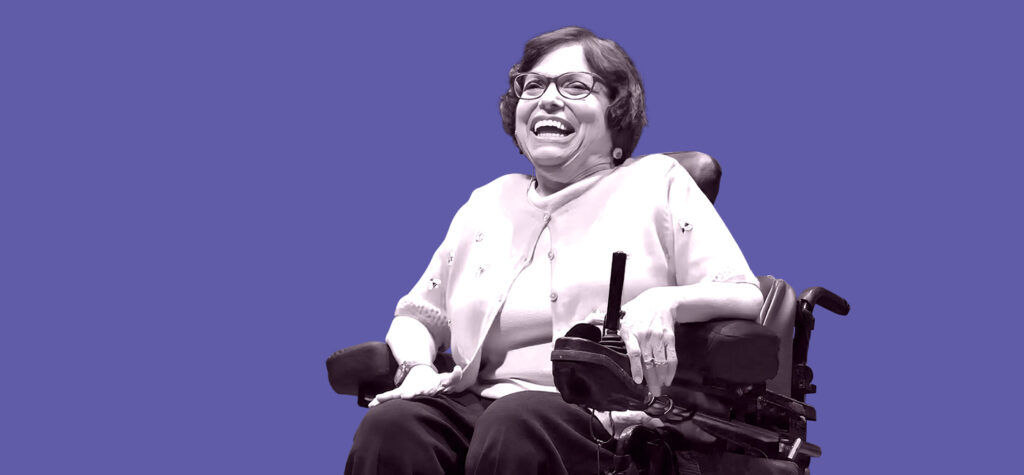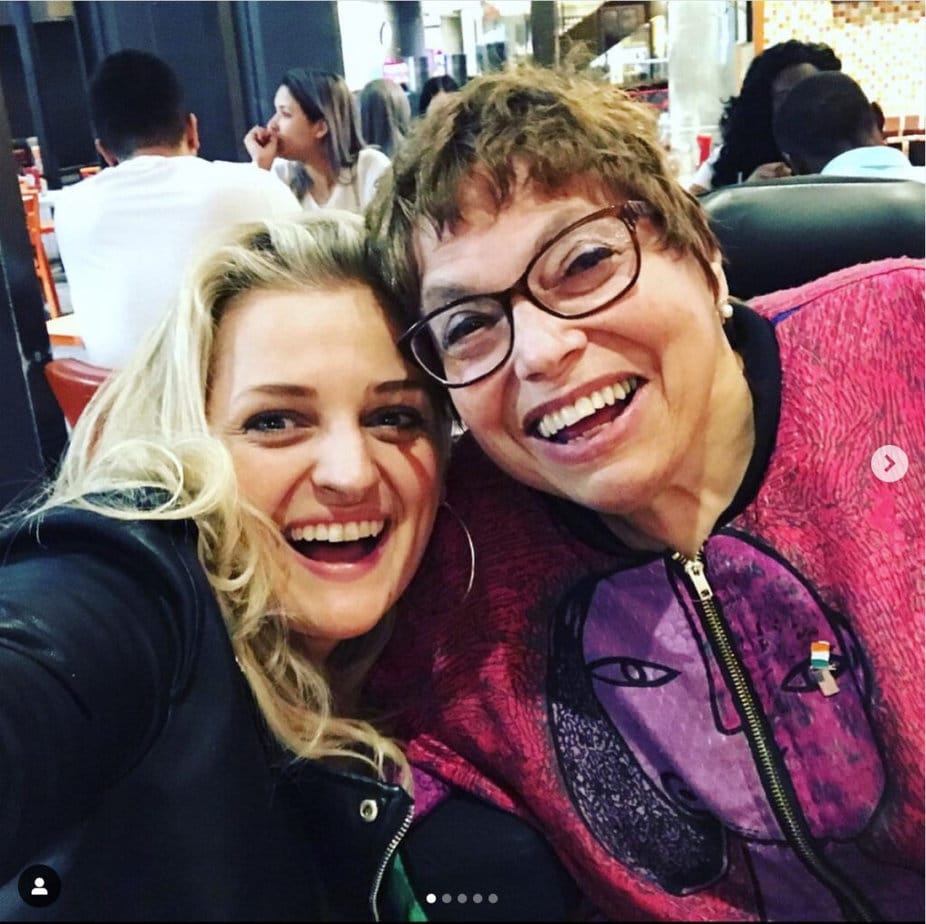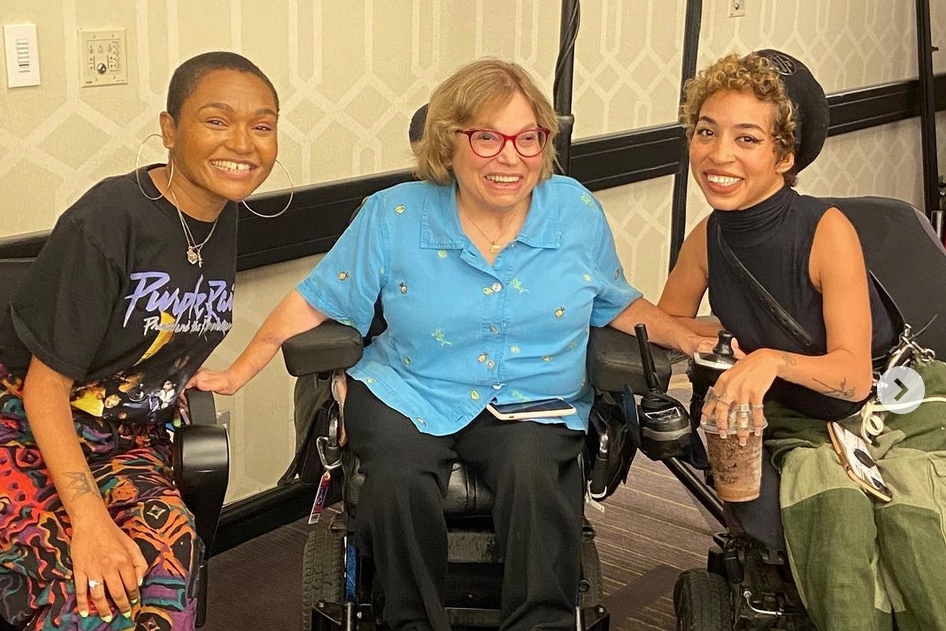
Disability rights pioneer Judy Heumann died on March 4 at the age of 75. When public figures die, it’s common for their stories to be inflated beyond their real-world impact. Heumann’s life and legacy need no such treatment — much of modern disability rights and culture can be traced to her leadership in fighting for our community.
We begin with an excerpt from her memoir that drops us into the most famous event of her career: the 504 sit-in in 1977. Fast-forward to a 1986 interview with Sam Maddox in which Heumann speaks about the profound importance of connecting with other disabled people. And for a post-ADA perspective, Emily Ladau shows that Heumann cemented her legacy by actively mentoring the next generation of disability leaders. She changed the world — and made sure the rest of us will keep at it, too.
In Her Own Words: An Excerpt from Being Heumann
It was April 1977, and officials at the federal Department of Health, Education and Welfare had delayed signing section 504 of the Rehabilitation Act of 1973 for four years. Fed up at this denial of civil rights, Judy Heumann and activists at the American Coalition of Citizens with Disabilities planned protests at 10 HEW offices around the country. Following the protests, activists stormed HEW offices and refused to leave until the regulations were signed. This excerpt finds Heumann and the sit-in leadership team occupying the office of Joseph Maldonado, the head of HEW’s San Francisco location. The occupation lasted 26 days, despite officials’ attempts to force out the protestors by restricting food, hot water and family visits. Oh, and they even tried to evict the activists with a fake bomb threat.
Day One
“An Occupation Army of Cripples Has Taken Over the San Francisco Federal Building” read one headline. Jim [Pechin]and I and the rest of the leadership team were gathered around Maldonado’s desk. Newspapers were spread out in front of us, and the little television in Maldonado’s office was on. Our sit-in was all over the Bay Area newspapers, television, and radio. A television segment reported, “It all started this morning here at the Old Federal Building at 50 Fulton Street when an incident took place outside. Immediately after that demonstration this morning, the handicapped started invading the building.” We were being talked about as if we were a foreign army. The public was stunned. People weren’t used to thinking of us as fighters — when they thought about us at all. And I don’t say that in a bitter way, but in more of an honest way. We were a people who were generally invisible in the daily life of society. I mean, think about it. If you didn’t see us in school, because we weren’t allowed in; or at your place of employment, either because we couldn’t physically access it or because we couldn’t get hired; or on your form of public transportation, because buses and trains weren’t accessible; or in restaurants or theaters, for the same reason — then where in your everyday life would you have seen us?
Breaking Down the Bureaucrats
Joseph Califano: The guy in charge. Secretary of the Department of Health, Education and Welfare, he was responsible for the four-year delay in signing Section 504 of the Rehabilitation Act of 1973.
Peter LiBossi: General counsel for HEW who served as de-facto negotiator during the sit-in, while occasionally giving up a little too much information.
Congressmen George Miller and Phil Burton: Sympathetic politicians who organized a congressional hearing at the sit-in, giving legitimacy to the protestors.
Gene Eidenberg: HEW underling sent by Joseph Califano who tried to run from the room and hide after being eviscerated by Heumann and other speakers at the congressional hearing.
Day Six (Easter)
California congressman George Miller suddenly walked in, completely unannounced. George Miller was around our age — he was just 32. Figuring out right away that we were on the phone with someone in DC, Miller quietly walked over to another phone and picked up the receiver. Silently he listened in as Peter [LiBossi] talked about the changes HEW was considering. “Peter,” he interrupted, “this is Congressman George Miller.” Abruptly Peter stopped talking. I don’t remember what was said after that exactly, but Peter basically hung up very quickly. The congressman put the phone down and turned to all of us in the room, a serious look on his face. “Stay,” he said. “Stay in this building and don’t leave until you’ve won.”
The next day Congressman Miller called to tell us that he and California congressman Phil Burton had agreed to hold a congressional hearing in the building. On Friday, at the end of the week. “Hooray!” we cheered, elated. It was a huge victory. A congressional hearing is a way for Congress to investigate, through the testimony of the public and experts, what’s going on with an issue. The fact that the representatives were not only planning on holding a congressional hearing but were planning on holding it in the building, meant that we had succeeded in elevating our issues to the point where Congress was getting involved with real sincerity.
Day Eleven
Congressman Burton opened the proceedings by stating that the intention of the hearing was to understand the nature of the conflict. Joe Quinn stood next to him, translating in sign language. I spoke first.
“You have given us respectability,” I said, thanking the congressmen. “We will not compromise any further. We will not be leaving this building until the regulations are signed as we want. This is a civil rights movement.” I paused, then continued, “You are helping us start a civil rights movement.”
Gene Eidenberg, the HEW representative from Washington, then read a statement on behalf of Secretary Califano and the undersecretary. The statement essentially repeated what we all already knew, that the regulations were under review.
The congressmen asked Eidenberg why signing the regulations was being delayed.
Eidenberg demurred, quoting issues of studies and reviews. Clearly, he’d been given his marching orders by the higher-ups at HEW. The fact that Califano even sent a somewhat lower-level bureaucrat to a congressional hearing spoke volumes about his attitude toward us.
The congressmen probed Eidenberg’s responses. What studies? For what purpose, exactly?
Eidenberg, growing obviously uncomfortable under their scrutiny, remained opaque. Awkwardly, he tried to explain HEW’s position. Rambling, he mentioned the words “separate but equal” and in the same sentence dropped the news that the number of issues under review had reached a total of 26.
The instant I heard this phrase something exploded inside me.
Still “separate but equal”? HEW was still considering a “separate-but-equal” approach? After all the support we’d gotten from the civil rights groups? Had they never heard of Brown v. Board of Education? In no other area of civil rights would the concept of “separate but equal” be tolerated, much less discussed with such insistence.
My insides churned with anger and frustration.
While I was desperately trying to maintain my composure in the front of the room, Kitty [Cone]slipped out the back. The minute Eidenberg had uttered the words “separate but equal,” she turned her chair around and rolled out the door. In front of the building, as the congressional hearing continued indoors, Kitty told the assembled crowd outdoors what Eidenberg had said about “separate but equal.”
The 800 protesters dissolved in an uproar so loud we could hear it inside. It was my turn to respond to the statement Eidenberg had read. I didn’t look at my notes.
Taking a deep breath, I looked directly at Eidenberg. “Whether there was a Section 504,” I said, my voice breaking, “there was a Brown v. Board of Education.” My voice broke again. I looked down, swallowed my tears, and looked back up at Eidenberg.
“The . . .” I stopped, suddenly overwhelmed by the weight and exhaustion of the days, the weeks, the years of pushing. Of having to fight, just for an equal chance to live.
I took another deep breath.
“The harassment. The lack of equity that has been provided for disabled individuals, and that even now is being discussed by the administration, is so intolerable that I can’t quite put it into words.” I could not keep my voice from trembling. With every word, I felt a memory weighing. Of being in my living room by myself, staring out the window, while all my friends were in school. At Brooklyn College, crying as my father carried me onto the stage. Knocking on doors in my dorm, looking for help to go to the bathroom. The flight attendants trying to throw me off the plane, all the passengers’ eyes on me.
“I can tell you,” I said, a force rising in me, “that every time you raise issues of ‘separate but equal,’ the outrage of disabled individuals across this country is going to continue, is going to be ignited. And there will be more takeovers of buildings until, finally, maybe, you’ll begin to understand our position.
“We will no longer allow the government to oppress disabled individuals. We want the law enforced! We want no more segregation! We will accept no more discussions of segregation . . .”
I paused. Eidenberg was nodding sympathetically at me. The look on his face was unbearable.
“And, I would appreciate it if you would stop nodding your head in agreement when I don’t think you have any idea what we are talking about!” I put my head in my hands and choked back my tears. The room burst in applause.
The next hour of testimony was a blur. So many people spoke.
“What Califano forgets is that while they sit around and intellectualize, what they don’t seem to understand is that our lives are not changed,” said Debbie Kaplan of the Disabilities Rights Center in DC.
Ed Roberts said, “For one of the largest minorities in the country, I have never seen a better blueprint for segregation.”
Denise Darensbourg, who was developmentally disabled, stated, “I might seem second class to them, but I’m a person like everyone else. I don’t think it’s fair to be put down. I went to a special school for the mentally retarded. I didn’t learn the things I should have. The attitude was that I couldn’t learn anyway, so why bother? I need help with some things, but not with all.”
In the midst of it all, Eidenberg seemed unable to decide his position. One minute he appeared pitying, the next unreadable, then frustrated. One by one, speaker after speaker got up, blind, deaf, physically disabled, former addicts, parents of disabled, sharing thoughts, feelings, pain, isolation, anger, heartbreak, telling of years spent trying to get a job, an education, trying to count, trying to matter.
Following the Congressional hearings in San Francisco, Heumann and an ACCD leadership group traveled to Washington D.C. to gather support for their cause while protestors continued the occupation. The leaders team lobbied senators and Carter administration officials, continued their media blitz and made life as uncomfortable as possible for Joseph Califano by holding nightly vigils outside his home. The pressure worked.
On April 28, 1977, Califano signed Section 504. It was day 26 of the sit-in, which was the longest occupation of a federal building and one of the most impactful. Section 504 established the foundation for federal disability access, and though the law was never widely enforced, it became the basis for the 1990 Americans with Disabilities Act, a fully-fledged civil rights law that changed life with disability in this country.
Used with permission of Beacon Press, from Being Heumann by Judith Heumann, copyright 2020; permission conveyed through Copyright Clearance Center, Inc.
Ones for the History Books: A Timeline
My Injustice is Your Injustice
by Sam Maddox
I interviewed Judy Heumann for my book SPINAL NETWORK (which hatched the magazine SPINAL NETWORK EXTRA, later renamed NEW MOBILITY). This would have been around 1986, a number of years after she had established herself as the badass matriarch of disability civil rights.
I asked Heumann to direct comments to a prospective audience of early- to mid-stage spinal cord injured individuals with some or little awareness of civil rights activism. She took me to school on the systemic indifference — and appalling discrimination — facing people living with disabilities. Heumann was wonderfully articulate and accommodating. It wasn’t just her baked-in-the-’60s social justice rhetoric. She could be fiery, and impassioned. As she tells her story, you understand and feel her rage. Heumann’s power came from knowing how to speak her truth to convince you that her injustice is your injustice. She was a true leader.
Her message, and her legacy: Be seen, find your allies, accept nothing less than your rightful share. Confront the system with outrage, strength and resilience.
Verbatim from Judy:
One of the problems for newly injured individuals is that they grew up so believing that my life was a tragedy, that they believe their life is a tragedy. And as long as you believe your life is a tragedy, you can’t do very many good things with your life. Once you believe the tragedy isn’t your fault, that it is the failure of the political system to acknowledge your rights as a human being, to be equal within the society, that you can as an individual have a voice as part of a group, then you can make a difference.
You have to psych yourself up, to really believe you are not going to let those people take something away from you that’s yours. It means you’re putting yourself out there, and your differences are going to be seen.
Her message and her legacy: Be seen, find your allies, accept nothing less than your rightful share. Confront the system with outrage, strength and resilience.
You can’t be embarrassed about how you look different. When you are not embarrassed, and feel good that you are who you are, this enables you to do things. But do it as a group. I think the group support lets you strategize together, rap together, cry together, lets you be strong together; the group gives you that real sense of strength and optimism and resilience that most people don’t have by themselves — I certainly don’t.
It is critically important that the person reading this is developing a better sense of self, and acknowledge that the oppression is put on them by others, that they are not bad people. …
I recently had an experience in New York, waiting to take the bus from Manhattan to Brooklyn. A number of drivers had passed me by, so I jammed my chair into the stairs of the next bus and told the driver that if I wasn’t going, he wasn’t going. This was a very emotional experience for me. I was really scared, and really angry, and I was ready to cry. Some guy had come off the bus and started kicking my chair, trying to shove me away. Here we had accessible buses that we weren’t being allowed to use. I realized that if I didn’t take things into my own hands, nothing would happen. Well, I certainly got on that fucking bus, but it took a while.
This kind of story needs to be told, because it lets other people know they have rights; that is the issue. We have a right to these things. A lot of disabled people are afraid of getting on the bus; it’s a profound thing, having the fear of being confronted by nondisabled people who they think might be upset if the lift breaks down. You really need support of the group to say, “I have a right to be on this bus.” and to know that the bus has broken down for years before there was a lift on it. …
Once you can finally realize that unless you take things into your own hands, things aren’t going to change, that is such a sense of power. Not as an individual person, but as a group — the power of the group is very overwhelming.
She Passed the Torch to All of Us
On social media platforms, wheelchair users from all over the world thanked Heumann for the impact she had on their lives. What was most striking about the outpouring was how many younger leaders in the disability community had personal interactions and photos with Heumann. Clearly, she was committed to passing the torch. See 10 of our favorite social media tributes.


For more on Heumann’s Legacy, read Emily Ladau’s piece about her personal relationship with Heumann and how the disability-rights icon never stopped mentoring and connecting the next generation of advocates.
Support New MobilityWait! Before you wander off to other parts of the internet, please consider supporting New Mobility. For more than three decades, New Mobility has published groundbreaking content for active wheelchair users. We share practical advice from wheelchair users across the country, review life-changing technology and demand equity in healthcare, travel and all facets of life. But none of this is cheap, easy or profitable. Your support helps us give wheelchair users the resources to build a fulfilling life. |


Recent Comments
Suzanne on Phoenix i is the First Wheelchair with Integrated Power Assist
Earl on The Inaccessible Path to Enlightenment
Earl on The Inaccessible Path to Enlightenment